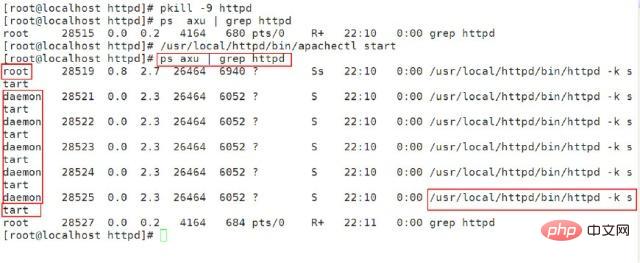
Linux method to check whether the service is closed: 1. Use the ps command, which can check the processes in the system. The syntax is "ps aux | grep service name"; 2. Use the netstat command, which is used to Display network status, the syntax is "netstat -tunple | grep service port".

#The operating environment of this tutorial: linux7.3 system, Dell G3 computer.
1.# ps aux | grep service name (ps parameters can be used upside down, no problem)
PS is one of the Linux system commands. It is a command to view the process in Linux. ps to view the running process, ps aux to view all processes.
The Linux process has 5 states
Running state (running or waiting in the run queue [Ready Queue])
Interrupted state (sleeping, blocked, waiting for a certain condition to form or receiving a signal)
Uninterruptible state (not waking up and not running when receiving a signal, process Must wait until an interrupt occurs)
Zombie state (the process has been terminated, but the process descriptor exists until the parent process calls the wait4() system call and is released)
Stop state (the process stops running after receiving SIGSTOP, SIGSTP, SIGTIN, SIGTOU signals)
Examples are as follows:

2, # netstat -tunple | grep service port
Linux netstat command is used to display network status.
Using the netstat command allows you to know the network status of the entire Linux system.
Syntax
netstat [-acCeFghilMnNoprstuvVwx][-A<网络类型>][--ip]
Parameter description:
-a or --all Display all sockets in the connection.
-A
-c or --continuous continuously lists network status.
-C or --cache displays the cache information of the router configuration.
-e or --extend displays other network-related information.
-F or --fib displays the route cache.
-g or --groups Display the list of multicast function group members.
-h or --help online help.
-i or --interfaces displays the network interface information form.
-l or --listening displays the Socket of the server being monitored.
-M or --masquerade displays masqueraded network connections.
-n or --numeric uses the IP address directly without going through the domain name server.
-N or --netlink or --symbolic Displays the symbolic link name of the network hardware peripheral device.
-o or --timers Display timers.
-p or --programs displays the program identification code and program name that are using Socket.
-r or --route displays the Routing Table.
-s or --statistics displays network work information statistics table.
-t or --tcp displays the connection status of the TCP transmission protocol.
-u or --udp displays the connection status of UDP transmission protocol.
-v or --verbose displays the instruction execution process.
-V or --version displays version information.
-w or --raw displays the connection status of RAW transmission protocol.
-x or --unix The effect of this parameter is the same as specifying the "-A unix" parameter.
--ip or --inet The effect of this parameter is the same as specifying the "-A inet" parameter.
Examples are as follows:

Recommended learning:Linux video tutorial
The above is the detailed content of How to check if the service is closed in Linux. For more information, please follow other related articles on the PHP Chinese website!